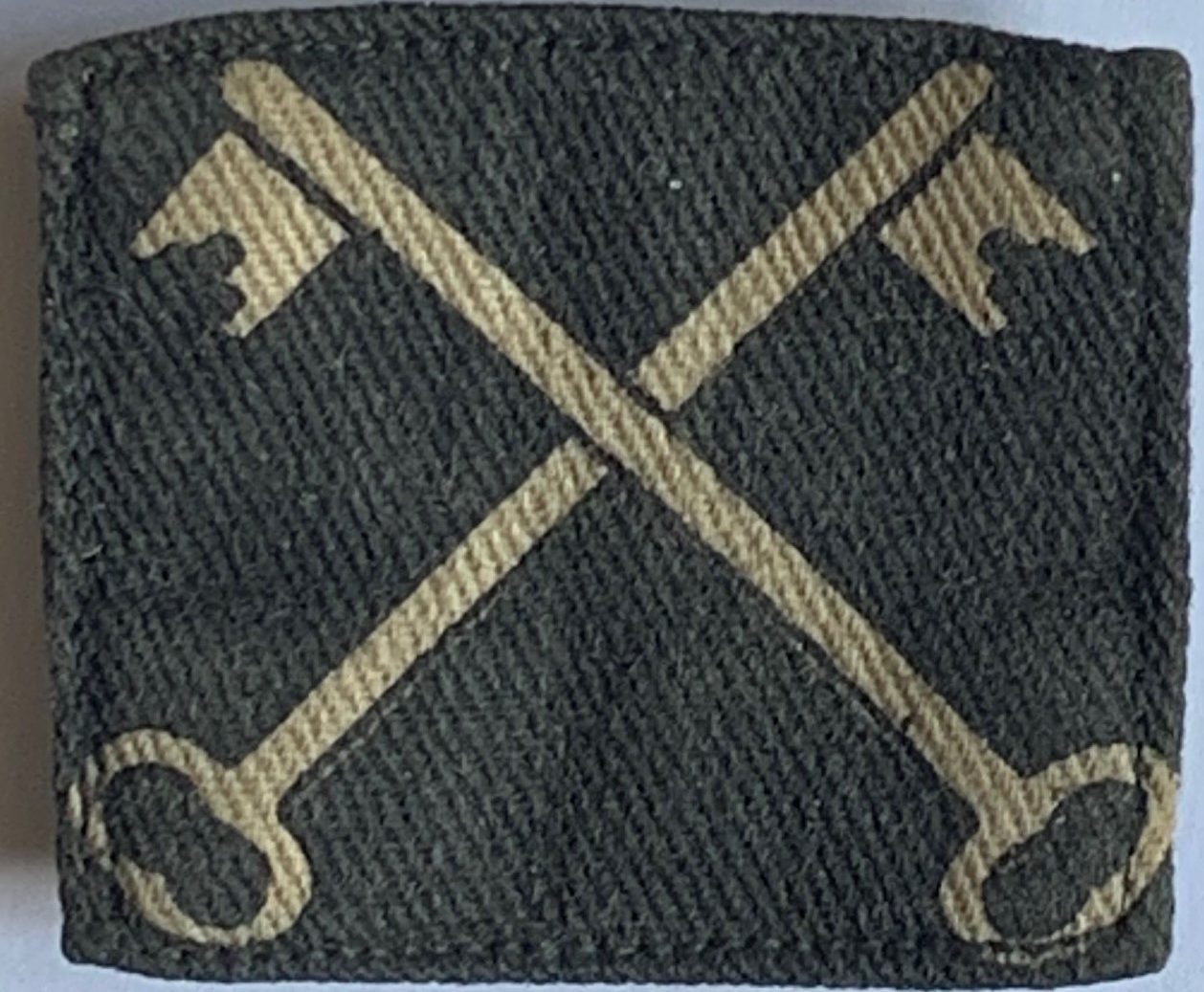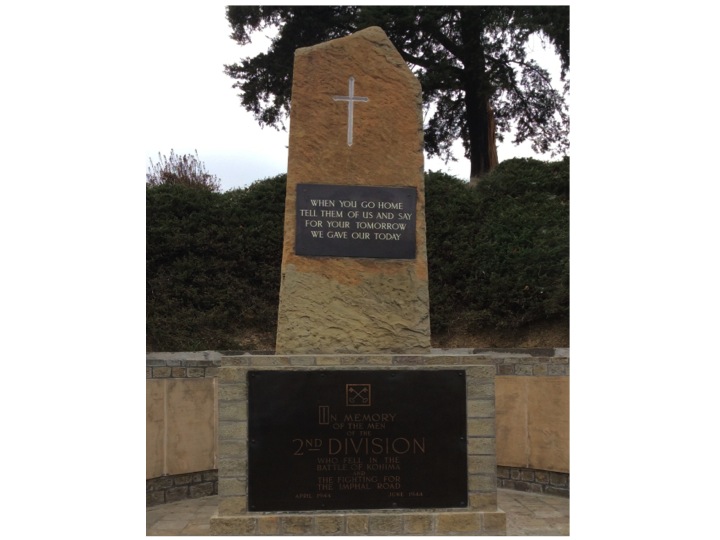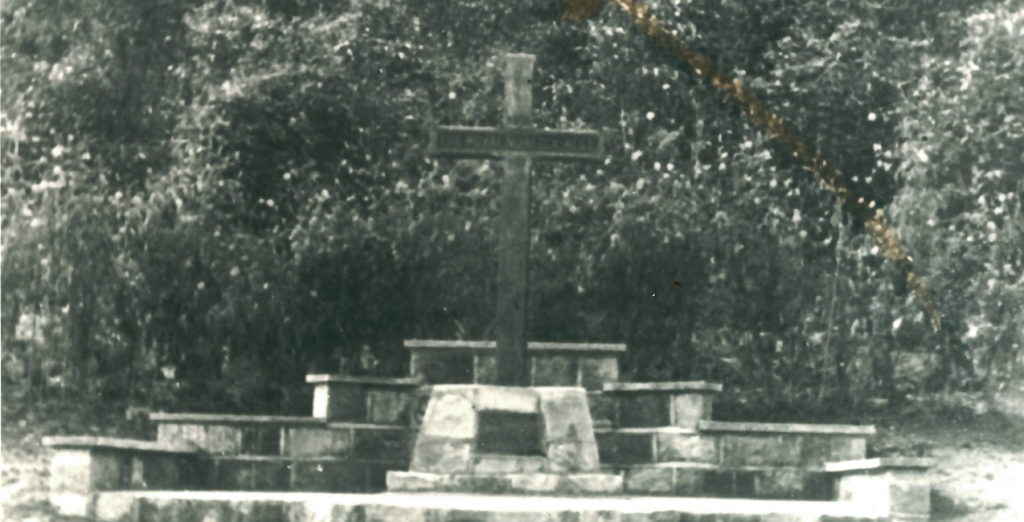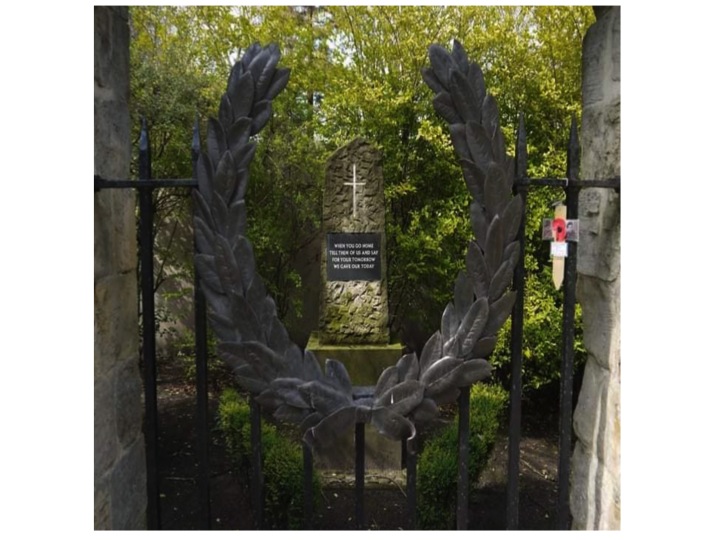Kohima War Cemetery
Kohima War Cemetry lies on the site of the Deputy Commisioner’s bungalow & the terraced gardens rising behind it, between Garrison Hill & the northern tip of Kohima Ridge. It contains 1420 graves of Commonwealth troops who died in the Second World War. Of these, 330 were Indian, 5 Canadian, 3 Australian & 1082 British.
The original wooden crosses were eventually replaced with stone slabs.

At the top of the Cemetery stands the Kohima Cremation Memorial, which commemorates 917 Sikh & Hindu soldiers of the Indian Army, whose remains were cremated in accordance with their customs. It bears the inscription:
“Here, around the tennis court of the deputy commissioner, lie men who fought in the battle of Kohima in which they and their comrades finally halted the invasion of India by the forces of Japan in April 1944.”
A Cross of Sacrifice was erected on the terrace where the tennis court lay, site of some of the bitterest fighting. The ground alongside the Cross was marked out as a tennis court, in remembrance of the men who fought there.
2 Division Memorial
At the lower, northern end of the cemetery is a stone monument, 15 feet tall, to the fallen of the British 2nd Division, bearing the famous epitaph:
“When you go home tell them of us and say for your tomorrow we gave our today.”
This epitaph is credited to British classicist John Maxwell Edmunds & is based on a Greek epitaph by Simonides of Ceos for the 300 Spartans, led by Leonidas, who defended the mountain pass at Thermopylae against invasion by the enormous army of Persian King Xerxes.
The stone was one of several Naga obelisks that had been erected near Maram, thirty miles from Kohima. The Nagas gave permission for it to be used to commemorate 2 Division at Kohima. It was transferred with the aid of a crane & a tank-transporter, before Nagas manhandled it into position at the foot of the cemetery.
161 Brigade Memorial
There is also a memorial to 161 Brigade of 5 Indian Division, containing 1/1 Punjab, 4/7 Rajputs & 4 Royal West Kents, which played a critical role during the Siege of Kohima. Without them, Kohima would undoubtedly have fallen.
The inscription at the top of the memorial includes the following words by Lieutenant John Wright:
“At Kohima in April 1944 the Japanese invasion of India was halted”
Regimental Memorials
Several of the British & Indian regiments that fought at Kohima erected their own monuments. Not all of these have survived the eighty years since the battle.
1 Assam Regiment
In 1944, 1 Assam Regiment was the youngest unit in the Indian Army, raised just 3 years previously from local hill-men, including many Nagas. Nevertheless, it performed heroically in its baptism of fire, delaying the advance of the Japanese at the Battles of Jessami & Kharasom (March 27-31). A Memorial to this can be seen at Jessami.
The commander of 1 Assam at this time was Lieutenant Colonel ‘Bruno’ Brown. Eighty years later, his grandaughter Charlotte Carty laid a wreath at the Regiment’s Memorial at Jessami.
A memorial to Lieutenant ‘Jock’ Young, who commanded the Assams at Kharasom, can be found where he lived in Scotland.
After the Battles of Jessami & Kharasom, the surviving Assams marched 78 miles back to Kohima in 39 hours, through Japanese ambushes & friendly fire from the RAF. The Regimental history states that 37 men were killed in action before the Battle of Kohima & a further 25 were killed fighting at Kohima. A Memorial to 1 Assam is preserved at Kohima, in recognition of their officers & men “who gave their lives in the cause of freedom during the world war 1939-1945”.


General Bill Slim later told 1 Assam Regiment
“You may be the youngest unit under my command, but you’re pretty precocious”.
5 Division, 161 Brigade
Queen’s Own Royal West Kent Regiment
The men of 4 Royal West Kents erected a wooden cross at Kohima in memory of the 78 of their comrades who were killed during the Siege.
The text reads:
This wooden cross is now preserved in the regimental gallery of Maidstone Museum in England.
The fallen of 4 Royal West Kents are now commemorated on a stone plaque in Kohima War Cemetery.

1 Punjab and 7 Rajput Regiments
Brigaded with 4 West Kents were 1/1 Punjab & 4/7 Rajputs. They are commemorated on Kohima Cremation Memorial. According to the casualty records of 33 Corps, 1/1 Punjab had 47 killed, 25 missing & 188 wounded during the Battle of Kohima, including two officers killed & six wounded. The 4/7 Rajputs suffered 15 killed, 23 missing & 157 wounded. Some of the Regiments’ fallen are named on the Kohima Cremation Memorial.
2 Division, 4 Brigade
The Royal Scots
According to regimental records, the 1st Battalion Royal Scots lost 89 killed and approximately 200 wounded at the Battle of Kohima.
A committee from the Battalion designed a monument, that was constructed from local stone by the Pioneer Platoon. It is sited at Kennedy Hill, on the Aradura Spur, & was unveiled on 25 November 1944 by the Battalion’s Commanding Officer, Lieutenant Colonel Masterton Smith, who had fought throughout the Battle of Kohima.

The Monument, overseen by The Commonwealth War Graves Commission, is now surrounded by local housing, but (in 2017) was reported as being in good order & looked after carefully by the family living beside it.
The Royal Norfolk Regiment
A competition was held amongst the Norfolks to design a memorial to the 7 officers & 76 men of 2nd Battalion who were killed at the Battle of Kohima. Sergeant Curtis of the Pioneer Platoon submitted the winning design & built it with his men from local materials. It was placed on a small plateau ten feet above the Imphal Road between Transport (GPT) Ridge & the Aradura Spur.
The Memorial was unveiled on 22 October 1944 by Major General Nicholson, Commander of 2 Division.
The Lancashire Fusiliers
33 Corps casualty figures list 8 officers & 58 men of 1/8 Lancashire Fusiliers killed at Kohima, 9 officers & 220 men wounded & 2 missing. A brass board in remembrance of the fallen is at the Royal British Legion in Salford, England.
2 Division, 5 Brigade
The Queen’s Own Cameron Highlanders
1st Battalion Queen’s Own Cameron Highlanders lost 96 killed in the Battle of Kohima, including 4 officers, & 164 wounded, of whom 6 were officers. Most of these casualties were in the bitter fighting for the Naga Village there. For this reason, the Battalion’s memorial was placed in that village, on the highest point of the Knoll.
The Camerons designed and built the Memorial. It bears a brass plaque listing the names of the fallen, beneath a kilted highlander playing bagpipes & the words ‘Lochaber No More’. This is the title of an 18th century lament by poet Allan Ramsay, describing a highland soldier’s leave-taking for active service abroad, doubting that he will ever return.

When the memorial was unveiled, there were present at the ceremony not only the officers & men of the battalion, but also many Naga tribesmen, whose homes were near the Knoll where the memorial stands, scene of bitter fighting.
The service was brief & moving. The adjutant read the names of the members of the battalion who died during the Battle of Kohima. A piper then played ‘Lochaber no more’ & wreaths were placed by the Commanding Officer, second in command, & representatives of each company, as well as a wreath from the Queen’s Own Cameron Highlanders of Canada.
A Naga headman stepped forward from beside the Commanding officer & the Deputy Commissioner. He stood before the memorial with head bowed, then promised in his own language that his people would look after the memorial always, in honour of the men killed there. It was a moving gesture from those Highlanders of Asia.

In 2011, another plaque was added promising that the Nagas who live there will care for the monument until the sun stops shining or the wind stops blowing. This was probably intended to mean forever, rather than a reference to climate change.
Serjeant ‘Nivi’ Nivison was amongst the Camerons in 1944. In 2022, his son Ian Nivison & great grandson Kai Chacksfield visited the Cameron’s memorial & attended the KET Scholarship awards ceremony, where they met the Naga student they generously sponsored with a five-year scholarship.
The Dorsetshire Regiment
33 Corps casualty records state that 3 officers & 68 men of 2nd Battalion Dorsetshire Regiment lost their lives in the Battle of Kohima, 18 were missing & 199 wounded, including 9 officers. The Battalion built a simple stone monument, close to the tennis court.
It remains there, within Kohima War Cemetery.

The Worcestershire Regiment
33 Corps casualty figures for 7 Battalion Worcestershire Regiment in the Battle of Kohima are 4 officers & 28 men killed, 3 officers & 125 men wounded. However, a plaque in Worcester Cathedral gives the names of 4 officers & 40 men of 7 Battalion killed in the battle.

2 Division, 6 Brigade
The Royal Berkshire Regiment
According to 33 Corps records, 1 Battalion Royal Berkshire Regiment lost one officer & 51 men killed, 15 men missing & 290 men wounded, including 17 officers. They unveiled a memorial in 1944, beside the graves of some of the battalion’s dead on Garrison Hill.
The Imperial War Museum has film of the memorial & of a parade with a band playing a slow march. The opening material seems rather random, but what follows is striking, although of poor quality. Two stills are shown below.


The original memorial has not survived. Instead, there is now a simple tablet in the Kohima War Cemetery.

A plaque bearing the names of the killed & missing of 1 Battalion Royal Berkshire Regiment was displayed at the 2 Division Memorial in Kohima. It is now kept at The Rifles Berkshire & Wiltshire Museum in Salisbury, England.

The Royal Welch Fusiliers
The casualty lists of 33 Corps record that 1 Battalion Royal Welch Fusiliers suffered 52 killed, including 5 officers, 35 missing & 150 wounded, 11 of whom were officers. The Pioneer Platoon erected a memorial on Kuki Piquet. It was a cross on top of a tablet of white concrete, eight foot tall, bearing the inscription:
Erected by Officers & Men of a Battalion of The Royal Welch Fusiliers. April-June 1944. In proud & loving memory of our comrades who fell in the battle of Kohima-Manipur Road. “Ond Nid yn Ofer”
“On nid yn ofer” is Welsh & can be translated as “But not in vain”. At the foot of the memorial was a Roll of Honour scroll, with the names of 76 men of the Battalion who died in the Battle. This likely includes many of the men who were recorded as missing in the 33 Corps returns & perhaps some who died afterwards of wounds sustained in the battle.
By the late 1960s, this memorial had deteriorated beyond repair & so it was replaced by a new Memorial Panel in Kohima War Cemetery.

The Durham Light Infantry
Eight officers & 89 other ranks of 2 Battalion Durham Light Infantry were killed in the Battle of Kohima, according to the casualty records of 33 Corps. A further two officers & 38 men were recorded as missing. An additional 12 officers & 238 other ranks suffered wounds.

A Roll of Honour listing the fallen was placed on Garrison Hill. This has now gone, but a stone Memorial remains.
A brass plaque listing the men of 2 DLI killed at Kohima can be found at Durham Cathedral, where there is also a DLI Memorial Chapel with a Book of Remembrance recording the names of the regiment’s fallen in WW2.
Divisional Infantry
2 Recce Regiment
During the Battle of Kohima, 2 Recce Regiment suffered 22 fatalities, one missing & 34 wounded, according to 33 Corps records. However, 32 names were listed on their memorial. The discrepancy might be explained if some of the wounded failed to recover.
The pictures below were taken on the day the memorial was unveiled. It has not survived.
2 Manchester Regiment
According to 33 Corps casualty records, 16 men of 2 Manchester Regiment were killed in the Battle of Kohima, 30 men & 2 officers were wounded, & 4 men were recorded as missing. In July 1944, the men of 2 Manchester Regiment created a memorial to their fallen comrades at milestone 80 of the Imphal Road. It is no longer there.
7 Division, 33 Brigade
The Queen’s Royal Regiment
33 Corps casualty records for 1st Battalion Queen’s Royal Regiment in the Battle of Kohima give 47 killed, 23 missing & 140 wounded, including 3 officers killed & 11 wounded. Their memorial at Kohima lists 63 as killed in action.
The battalion’s Pioneer Platoon built a fine stone Memorial on Jail Hill, where they suffered their heaviest losses. It was unveiled on 31 August 1944. The Imperial War Museum has a brief film of the unveiling ceremony. Some stills are shown below. The Pioneer Platoon fired into the air & men marched forward individually to salute the Memorial. Many waiting in the background were wearing monsoon capes, but these were removed to approach the Memorial.

The Memorial on Jail Hill has not survived. However, a large plaque listing those killed from 1 Queen’s Royal Regiment can now be found in Kohima War Cemetery.

1st King George V’s Own Gurkha Rifles
In addition, to the fallen Queensmen, the memorial above lists thirteen fallen of 4/1 King George V’s Own Gurkha Rifles, who were also part of 33 Brigade. This is considerably fewer than the 35 men of 4/1 Gurkha Rifles who were listed as killed in 33 Corp’s casualty records. One of the 4/1 Gurkha Riflemen is named on the Memorial to the Cremated in Kohima War Cemetery.
15th Punjab Regiment
The third battalion of 33 Brigade was 4/15 Punjab, who had 57 killed, 7 missing & 250 wounded, according to 33 Corps casualty records. The battalion erected a Memorial detailing the names of 68 of their fallen, who were killed on Detail (DIS) Hill on May 11-13 & on Church Knoll of Naga Village on May 24-29. This is close to the Kohima War Cemetery, beside a busy road. Six of the 4/1 Gurkha Rifles are also named here, from a company that was under command of 4/15 Punjab.
The Memorial to the Cremated in Kohima War Cemetery lists 35 fallen from 15 Punjab Regiment, at least some of whom are also commemorated on the Memorial above.

Dean’s Park, York Minster
The monument to 2nd Division is reproduced in smaller size in the Dean’s Park beside York Minster. Here, a Memorial Service is held each July, organised by the Kohima Educational Trust. After the laying of wreaths, many of the congregation go to Imphal Barracks for lunch & to visit the Kohima Museum.
India Peace Memorial
In 1994, the 50th anniversary of the Battles of Imphal & Kohima, the Japanese government funded the India Peace Memorial. It was built at Red Hill on the Tiddim Road, the site of bitter fighting on May 20-29 1944. This was the closest the Japanese attack from the south got to Imphal.
























































